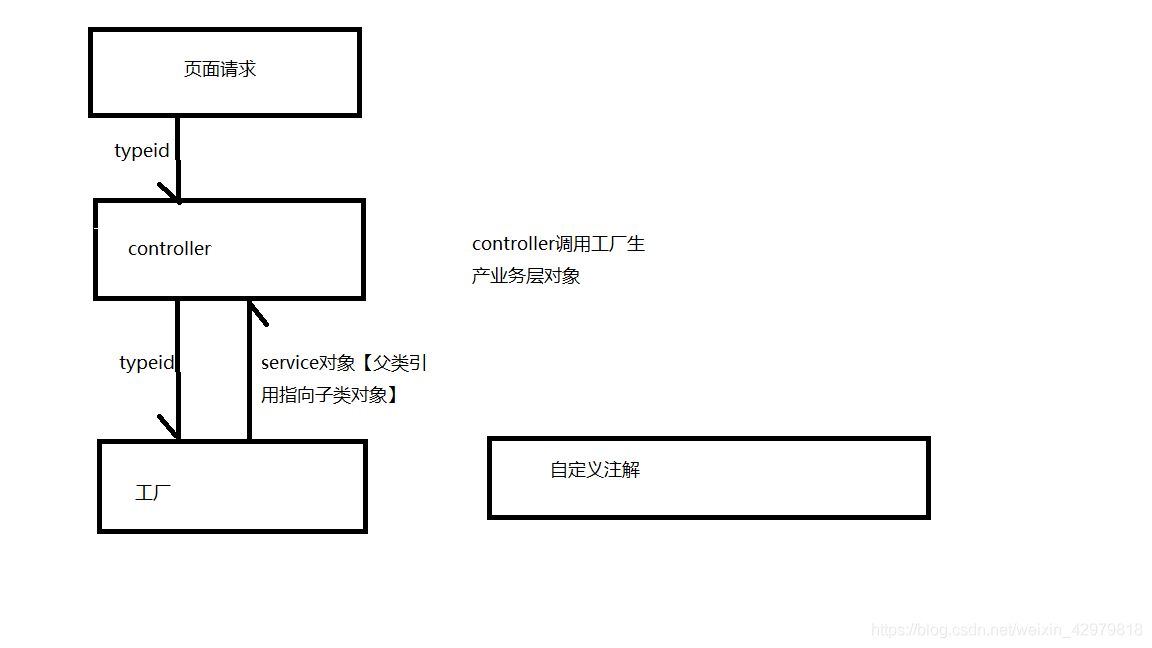本文中说的这个业务逻辑适用于多个渠道的选择的业务逻辑,而且之后渠道还会进行添加。
这段逻辑可以提高代码的维护性
以支付渠道为例
当项目中存在多渠道支付的时候就会存在渠道的选择问题,如果还用if。。。esle。。。
这种方式对于维护的难度就突飞猛进,如果改错一个,整个代码就炸了。这个锅还是不要背的
 首先来分析一下,支付渠道逻辑中。支付是共性,渠道是特性
首先来分析一下,支付渠道逻辑中。支付是共性,渠道是特性
支付我们就可以抽出一个接口,渠道就可以作为实现类中的逻辑
 这个自定义注解@pay后边会讲
这个自定义注解@pay后边会讲
package com.example.cloudclient.Service;
public interface PayBank {
String payStwitch(Integer payId);
}
package com.example.cloudclient.Service.impl;
import com.example.cloudclient.Service.PayBank;
import com.example.cloudclient.zhujie.Pay;
import org.springframework.stereotype.Service;
@Pay("1")
@Service("PayBankService")
public class PayBankServiceImpl implements PayBank {
@Override
public String payStwitch(Integer payId) {
return "第一家";
}
}
package com.example.cloudclient.Service.impl;
import com.example.cloudclient.Service.PayBank;
import com.example.cloudclient.zhujie.Pay;
@Pay("2")
public class PayBankServiceImpl2 implements PayBank {
@Override
public String payStwitch(Integer payId) {
return "第二家";
}
}
这样渠道的就有了,之后我们就该考虑怎么进行选则渠道,
对渠道的选则说白了就是对实现类的选则,最后调用的方法都是payStwitch
这个方法,在页面进行选则的时候一定会穿到后台一个唯一标识进行区分,
我设像写一个方法 ,我传给你一个标识id你给我返回一个对象(接口指向实现类对象)
对于创建对象这个事,我认为工厂模式还是比较合适的
一个id对应一个对象,就想到用map来存放,想个办法把实现类对象都放进来(总不能一个一个new吧)
于是这边想到反射。
这时@pay注解就就起到了两个作用,关联唯一id与对象之间的关系,然后扫描所有带有pay注解的类
Reflections是反射工具类,reflections.getTypesAnnotatedWith这个方法可以获取所有带有某个注解的类的全限定名
这个map的key就是唯一id(@pay()括号里的值,当然这个值要于页面值相对应),value就是对应类的全限定名。
这样通过反射就可以创建对象了
package com.example.cloudclient.BankFactory;
import com.example.cloudclient.Service.PayBank;
import com.example.cloudclient.Service.impl.PayBankServiceImpl;
import com.example.cloudclient.zhujie.Pay;
import org.reflections.Reflections;
import org.springframework.beans.factory.annotation.Autowired;
import org.springframework.stereotype.Service;
import java.lang.annotation.Annotation;
import java.util.HashMap;
import java.util.Map;
import java.util.Set;
public class BankFactory {
public static BankFactory bankFactory = new BankFactory();
public static Map<String,String> map = new HashMap<>();
static {
Reflections reflections = new Reflections("com.example.cloudclient.Service.impl");
Set<Class<?>> typesAnnotatedWith = reflections.getTypesAnnotatedWith(Pay.class);
for (Class c : typesAnnotatedWith){
Pay annotation = (Pay) c.getAnnotation(Pay.class);
map.put(annotation.value(),c.getCanonicalName());
}
}
public PayBank creat(String typeId) throws ClassNotFoundException, IllegalAccessException, InstantiationException {
String s = map.get(typeId);
Class<?> aClass = Class.forName(s);
PayBank o = (PayBank) aClass.newInstance();
return o;
}
public static BankFactory getInstance(){
return bankFactory;
}
}
package com.example.cloudclient.zhujie;
import java.lang.annotation.ElementType;
import java.lang.annotation.Retention;
import java.lang.annotation.RetentionPolicy;
import java.lang.annotation.Target;
@Retention(RetentionPolicy.RUNTIME)
@Target({ElementType.TYPE})
public @interface Pay {
String value();
}
package com.example.cloudclient.BankFactory;
import com.example.cloudclient.Service.PayBank;
import org.springframework.stereotype.Service;
@Service("payService")
public class Bank {
public String pays(String typeid){
BankFactory instance = BankFactory.getInstance();
String s = null;
try {
PayBank creat = instance.creat(typeid);
s = creat.payStwitch(12);
} catch (IllegalAccessException e) {
e.printStackTrace();
} catch (InstantiationException e) {
e.printStackTrace();
} catch (ClassNotFoundException e) {
e.printStackTrace();
}
return s;
}
}
只要controller来调用工厂里的creat方法就可以了
package com.example.cloudclient.controller;
import com.example.cloudclient.BankFactory.Bank;
import org.springframework.beans.factory.annotation.Autowired;
import org.springframework.stereotype.Controller;
import org.springframework.web.bind.annotation.PathVariable;
import org.springframework.web.bind.annotation.RequestMapping;
@Controller
@RequestMapping("/t")
public class PayController {
@Autowired
private Bank bank;
@RequestMapping("/test/{typeid}")
public void testPay(@PathVariable String typeid){
String pays = bank.pays(typeid);
System.out.println(pays);
}
}



 总结
总结
如果之后有新增的需求就可以不用管之前是怎么写的,自己新写一个类。值关注自己的业务代码就可以了

























 被折叠的 条评论
为什么被折叠?
被折叠的 条评论
为什么被折叠?








